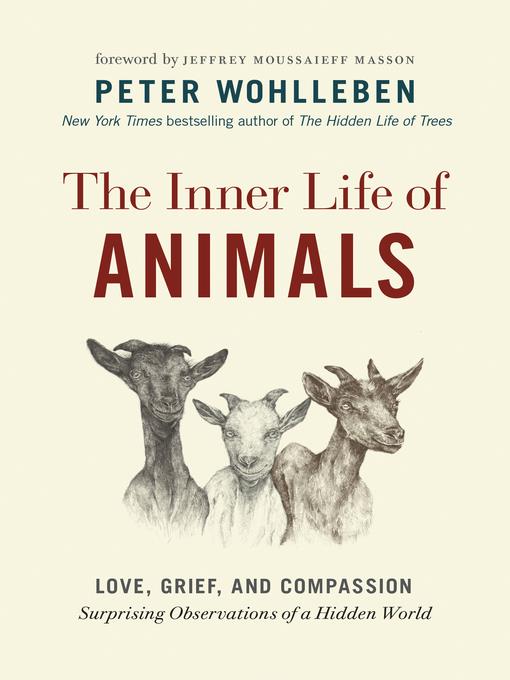
The Inner Life of Animals
Love, Grief, and Compassion—Surprising Observations of a Hidden World
فرمت کتاب
ebook
تاریخ انتشار
2017
Lexile Score
1100
Reading Level
7-9
نویسنده
Jane Billinghurstناشر
Greystone Booksشابک
9781771643023
کتاب های مرتبط
- اطلاعات
- نقد و بررسی
- دیدگاه کاربران
نقد و بررسی

October 1, 2017
Forester Wohlleben (The Hidden Life of Trees: What They Feel, How They Communicate--Discoveries from a Secret World, 2016) turns his attention to how animals feel.Writing nontechnically but with obvious depth of knowledge, the author invites readers to imagine that animals have many of the same feelings we do. His argument might not pass the most rigorous of scientific challenges, but it makes good sense. "Basically," he writes, "emotions are linked to the unconscious part of the brain. If animals lacked consciousness, all that would mean is that they would be unable to have thoughts." That does not presuppose, however, that animals cannot have emotions, since animals certainly have the same sorts of automatic nervous system responses humans have; in that view, maternal love may be hard-wired in deer or frogs just as much as it is in humans. All vertebrates, argues Wohlleben, share the same hardware, so to speak, for emotions, and he takes this down into other orders, noting, for instance, that fish produce oxytocin, "the hormone that not only brings joy to mothers, but also strengthens the love between partners," and that even single-celled animals can perform complex tasks involving awareness of their surroundings and, therefore, at least a kind of intelligence. And what of the love that an animal might feel for a human? In that instance, the author observes, the driving force may not be anything quite so immutable but instead a more variable quality: the ability to have curiosity about the world. The upshot is that humans need to give animals more credit for feeling--and therefore should not be so quick to eat them, to say nothing of other kinds of maltreatment. Indeed, on reading this gently learned book, readers will pay more attention to animals generally and learn how to be better neighbors to them.Can squirrels be said to be good or bad? For an answer to questions of that sort, this is the book to read. A treat for animal lovers of all stripes.
COPYRIGHT(2017) Kirkus Reviews, ALL RIGHTS RESERVED.

January 29, 2018
German forester and author Wohlleben follows The Hidden Life of Trees by turning his attention from flora to fauna, thoughtfully exploring questions about the range of emotions experienced by animals. In 41 short chapters, he considers examples of animals exhibiting humanlike feelings, including love, courage, desire, grief, regret, and playfulness, weaving a web of delightful and stirring anecdotes drawn from personal observations and scientific studies. The mating rituals of Wohlleben’s family’s billy goat may be attributed to instinct, but his descriptions of more complex emotions, such as the embarrassment he says the younger of their two horses shows if they reprimand her in front of an older horse or the gratitude demonstrated by crows, are more intriguing. Wohlleben’s anecdotes are enjoyable and thought-provoking, and take on a certain heft when shared alongside examples he takes from published scientific research, such as Koko, a female gorilla who learned to use sign language with help from a researcher at Stanford University. Wohlleben quickly whisks readers from one example to another, but they will find the brief encounters and Wohlleben’s musings enchanting and enlightening.

November 1, 2017
Wohlleben (The Hidden Life of Trees, 2016) offers an insightful consideration of the emotional and cognitive lives of animals. He takes a broad view, presenting stories about the behavior of various creatures including pigs, ticks, ravens, and bats. He is careful not to assign human feelings to the animals he writes about, but readers will be hard-pressed not to notice familiar reactions in both the engaging anecdotes and the clear scientific research he shares, and Wohlleben is conscious of this perspective throughout as he writes of animal regret, bravery, and empathy. The narrative is directed firmly at armchair naturalists and curious animal lovers who are intrigued by the possibilities presented by their pets' guilty or happy facial expressions or the chatty, communal behavior of birds flitting through their backyards. Wohlleben is also curious and proves a congenial guide as he strays beyond the familiar realms of dogs, cats, and bunnies. While this doesn't cover all-new territory, it does illuminate a field worthy of endless study, and pet owners especially will find it a winning read(Reprinted with permission of Booklist, copyright 2017, American Library Association.)

























دیدگاه کاربران